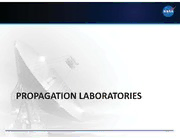
NASA Technical Reports Server (NTRS) 20150004097: Overview of Propagation Studies at NASA Glenn Research Center PDF
Preview NASA Technical Reports Server (NTRS) 20150004097: Overview of Propagation Studies at NASA Glenn Research Center
National Aeronautics and Space Administration Glenn Research Center at Lewis Field Overview of Propagation Studies at NASA Glenn Research Center James Nessel NASA Glenn Research Center Advanced High Frequency Branch January 22, 2015 Keeping the universe connected. Outline • Propagation Program Objectives • Program History • Summary of Current Propagation Campaigns • Modeling Activities • GRC Propagation Laboratories • Future Plans Program Objectives As NASA and the Nation move toward operations at Ka-band frequencies and above, it is desirable to characterize the site-dependent atmospheric propagation effects to manage expectations for system performance and develop improved systems at current and future potential operational sites. Objectives: • To provide a good understanding of RF propagation effects • To develop or validate models for the prediction of propagation- related effects • To develop techniques for the mitigation of these effects How to accomplish the objectives: • By making long-term measurements at multiple sites and analyzing the collected data • A timely and full dissemination of results to users of propagation data Program History Advanced Component Technology Satellite (ACTS) GRC possesses over 35+ station years of Ka-band propagation data collected through the Advanced Communications Technology Satellite (ACTS) program. Overview of Current Efforts Madrid, Spain • Phase Milan, Italy • Q-band Svalbard • Rain Attenuation • Gaseous Absorption Goldstone, CA • Scintillation • Brightness Temperature • Gaseous Absorption • Rain Attenuation • Phase Guam • Gaseous Absorption GRC Testbed • Brightness Temperature Cleveland, OH • Rain Fade • Phase Albuquerque, NM • Siittee DDiivveerrssiittyy • W/V-band/Optical White Sands, NM • Terrestrial Link • Gaseous Absorption • Rain Attenuation • Rain Attenuation • Scintillation • Phase Canberra, Australia • Phase Propagation Terminal Development ACTS Propagation Terminal Goldstone Interferometer White Sands/Guam Terminal Operational Frequency: 20.7/27.5 GHz Operational Frequency: 20.2 GHz Operational Frequency: 20.2 GHz Dynamic Range: 20 dB Dynamic Range: 30 dB Dynamic Range: 40 dB Sampling Rate: 1 Hz/10 Hz Sampling Rate: 1 Hz Sampling Rate: 1 Hz/10 Hz Resolution: <0.3 dB rms accuracy Resolution: <0.1 dB rms accuracy Resolution: <0.1 dB rms accuracy Hardware-based FFT Receiver Software-based FFT Receiver Software-based Frequency Estimation Receiver Throughout propagation campaigns, ground station hardware has undergone evolutionary improvements in performance and autonomous operation procedures. SITE SUMMARIES 7 Goldstone Campaign Atmospheric Phase Turbulence Studies Instrument : Two-Element Ka-Band Interferometer (20.2 GHz) Data Collection Started : May 2007 Data Collection Completed: September 2012 (but ongoing) Total Number of Months : 88 (7.3 Years) Collected 7+ years of atmospheric attenuation measurements Collected 7+ years of phase turbulence measurements Measurements have been validated with interferometer at secondary location at DSN Complex 8 White Sands Campaign Atmospheric Phase Turbulence Studies Instruments : Two-Element Ka-Band Interferometer (20.2 GHz) Microwave Profiling Radiometer (22-60 GHz) W/V-band Radiometer (82/72 GHz) Data Collection Started : February 2009 Total Number of Months : 68 (5.7 Years) Collected 5+ years of atmospheric attenuation measurements Collected 5+ years of phase turbulence measurements 9 White Sands Campaign Millimeter Wave Precursor Studies CDF of Total Path Attenuation [12/2012 - 08/2012] 100 72.5 GHz 82.5 GHz %]%] Exceeded [Exceeded[ 10 Abscissa Abscissa 1 me me TiTi Percent Percent 0.1 0.01 0 5 10 15 20 Attenuation [dB] CDF of Gaseous Attenuation CDF of Cloud Attenuation Extended dynamic range of radiometer from profile measurements at lower Instrument : Profiler, W/V-Band Radiometer frequency Data Collection Started : December 2012 Total Number of Months : 24 (2 years) Collected 2+ years of W/V-band gaseous and cloud attenuation measurements Extrapolation of profiler measurements/absorption models to W/V-band validated with direct W/V-band radiometer measurements 10
